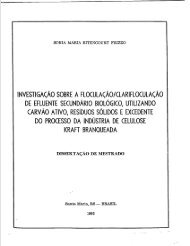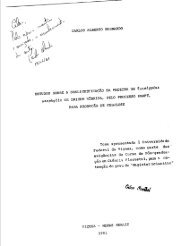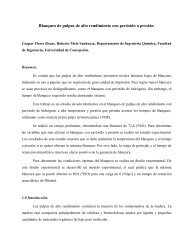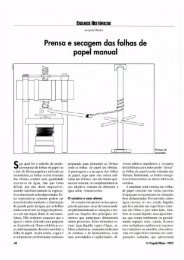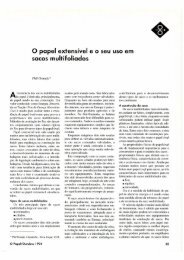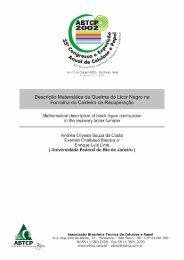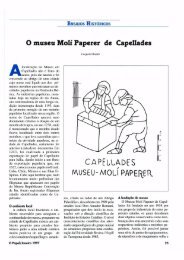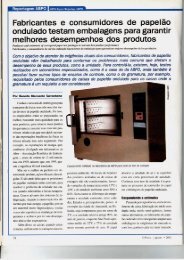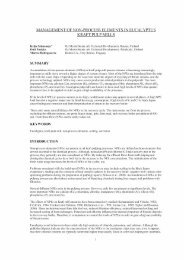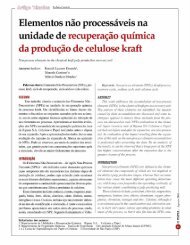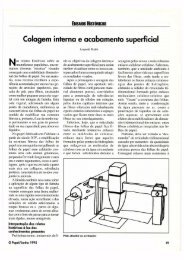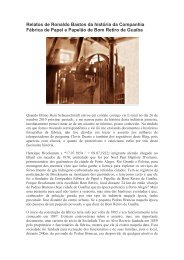O Eucalipto: um século no Brasil (The Eucalypt - Celso Foelkel
O Eucalipto: um século no Brasil (The Eucalypt - Celso Foelkel
O Eucalipto: um século no Brasil (The Eucalypt - Celso Foelkel
You also want an ePaper? Increase the reach of your titles
YUMPU automatically turns print PDFs into web optimized ePapers that Google loves.
A<br />
dificuldade em transportar as crescentes safras de café do Interior para<br />
o litoral, em lombo de burro, levou cafeicultores paulistas a criarem a<br />
Companhia Paulista de Estradas de Ferro que, em 1872 começou a operar<br />
o primeiro trecho, entre Jundiaí e Campinas. Bastaram 30 a<strong>no</strong>s, porém, para<br />
que as matas às margens da ferrovia tivessem sido inteiramente dizimadas para<br />
alimentar as locomotivas a lenha e assim em 1903 o chefe do escritório da ferrovia,<br />
engenheiro Adolpho Augusto Pinto, propôs o plantio de florestas para abastecer a<br />
O E U C A L I P T O - U M S É C U L O N O B R A S I L<br />
estrada de ferro.<br />
A carta informava que a ferrovia “consomia <strong>um</strong> milhão de dormentes por a<strong>no</strong> e<br />
600.000 metros cúbicos de lenha, sem que jamais tenha havido o “cuidado de<br />
replantar as mattas”. O autor prevê, inclusive para dentro de “alguns an<strong>no</strong>s, a mais<br />
completa penúria dos referidos materiaes”.<br />
Sensibilizado, o presidente da empresa, Antônio da Silva Prado, encomendou a seu<br />
apadrinhado, Edmundo Navarro de Andrade, <strong>um</strong>a pesquisa para resolver o problema.<br />
Navarro, nascido em 1881 em São Paulo, perdeu os pais muito jovem, foi<br />
criado pela conhecida dama paulista, Veridiana da Silva Prado e tentou cursar a carreira<br />
das armas, mas foi expulso do Colégio Militar por participar de <strong>um</strong> motim.<br />
N<strong>um</strong>a viagem a <strong>um</strong>a fazenda em Santa Cruz das Palmeiras, o escritor Eduardo<br />
Prado o convenceu a estudar agro<strong>no</strong>mia em Coimbra e a família Prado pagou seus<br />
estudos, dos quais resultou <strong>um</strong>a tese premiada pelo gover<strong>no</strong> português. Era <strong>um</strong><br />
estudo sobre controle das dunas.<br />
De volta, em 1903, foi <strong>no</strong>meado diretor do Serviço Florestal da Companhia Paulista<br />
e sua missão foi implantar o horto florestal nas terras para isso adquiridas em<br />
Jundiaí. Fez então o plantio de 95 espécies vegetais, cabreúva ‘Myrocarpus fron-<br />
dosos’, araucária ‘Araucaria angustifolia’, jacarandá ‘Jacaranda cuspidifolia’,<br />
jequitibá ‘Cariniana estrellensis’ e também de árvores exóticas, como o carvalho<br />
‘Quercus coccinea’, o cedro-do-líba<strong>no</strong> ‘Cedrus libani’, a casuarina ‘Casuarina<br />
cunninghamiana’, grevílea ‘Grevillea robusta’ e várias espécies de eucalipto<br />
‘<strong>Eucalypt</strong>us’, que não eram <strong>no</strong>vidade <strong>no</strong> <strong>Brasil</strong>.<br />
64<br />
<strong>The</strong> difficulties involved in transporting the increasingly large coffee<br />
harvests from the Interior of the state to the coast, on donkeys, led São<br />
Paulo coffee farmers to create the Companhia Paulista de Estradas de<br />
Ferro which, started operating its first section, between Jundiaí and Campinas,<br />
in 1872. It only took 30 years, though, for the forests next to the railway to be to-<br />
tally decimated to feed the steam engines and, as such, the head of the railway’s<br />
office, engineer Adolpho Augusto Pinto, proposed, in 1903, forests be planted to<br />
supply the railway.<br />
<strong>The</strong> letter informed the railway “cons<strong>um</strong>ed a million sleepers a year and<br />
600,000 cubic meters of firewood, without ever having “taking the care of<br />
replanting the forests.” <strong>The</strong> author goes as far as forecasting that in “a few years,<br />
there will be the most complete shortage of the mentioned materials.”<br />
Sensitized, the company’s president, Antônio da Silva Prado, ordered his protégé,<br />
Edmundo Navarro de Andrade, undertake a survey to solve the problem.<br />
Navarro, born in 1881 in São Paulo, lost his parents while very young and was raised<br />
by k<strong>no</strong>wn São Paulo madam Veridiana da Silva Prado and tried to enter the military<br />
forces, but was expelled from the Military School after participating in a mutiny.<br />
During a trip to a farm in Santa Cruz das Palmeiras, writer Eduardo Prado<br />
convinced him to study agro<strong>no</strong>my in Coimbra and the Prado family paid for his<br />
studies which resulted in a thesis that was awarded by the Portuguese govern-<br />
ment. It was a study on dune control.<br />
Back in Brazil, in 1903, he was named Forest Service director of the Companhia<br />
Paulista de Estradas de Ferro and his mission was to implement the forest nursery<br />
on lands that had been purchased for this purpose in Jundiaí. Hethen planted 95<br />
species of plants: cabreúva ‘Myrocarpus frondosos’, araucária ‘Araucaria angus-<br />
tifolia’, jacarandá ‘Jacaranda cuspidifolia’, jequitibá ‘Cariniana estrellensis’, and<br />
exotic trees as well, such as oak ‘Quercus coccinea’, o cedro-do-líba<strong>no</strong> ‘Cedrus<br />
libani’, casuarina ‘Casuarina Cunninghamiana’, grevílea ‘Grevillea robusta’, and<br />
several species of ‘<strong>Eucalypt</strong>us’, which were <strong>no</strong>thing new in Brazil.




